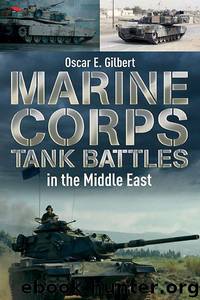Marine Corps Tank Battles in the Middle East by Oscar E. Gilbert

Author:Oscar E. Gilbert [Gilbert, Oscar E.]
Language: eng
Format: epub
Tags: HISTORY / Military / Iraq War (2003-2011)
ISBN: 9781612002682
Publisher: Casemate
Published: 2015-02-08T22:00:00+00:00
NOTES
1 Reynolds, Basrah, Baghdad, and Beyond, p. 79.
2 Ibid, p. 74.
3 The CAAT was a highly mobile unit mounted in lightly armored Humvees, and armed with a diverse mix of TOW missiles, light and heavy machine guns, and Mk19 40mm automatic grenade launchers. Their job was basically to look for trouble. Marine Corps tank platoons consist of five vehicles, and can be tactically subdivided into a light section of two tanks under the senior NCO and a heavy section of three tanks under the platoon leader.
4 Pritchard, Ambush Alley, p. 24.
5 The general outline of the following section is taken from Glover, H., Command Chronology Report for Calendar Year 2003, Company A, 8th Tank Battalion; Reynolds, Basrah, Baghdad, and Beyond, p. 75–85, and Pritchard, Ambush Alley. Where significant discrepancies exist, the Glover account is given priority. Some sources indicate the 507th Maintenance Company convoy had eighteen trucks; Richard S. Lowry, Tanks in the Garden of Eden.
6 Driven by PFC Lori Piestewa (died of injuries in captivity), was carrying Master Sergeant Robert Dowdy (killed instantly) and PFC Jessica Lynch (injured and captured). Far to the rear, public affairs officials and the press made much of Lynch’s supposed heroics, actually the deeds of PFC Patrick Miller (captured). To her credit, Lynch consistently strove to disabuse others of any notions of her supposed heroics. The lead element of the convoy acted according to doctrine, that any mobile vehicles should move out of the ambush kill zone, then attempt to assault the ambushers from outside the kill zone. Of course the 507th was not specifically trained or equipped to assault the ambush, and there were in any case too few of them to take on hundreds of ambushers.
7 Dunfee, Ambush Alley Revisited, p. 44. Dunfee strongly disputes the account of the battle presented by Bing and West, The March Up.
8 Pritchard, Ambush Alley, p. 31. The tank unit commanders thought the battalion staff tried to micromanage the action, and there was a constant radio chatter that often precluded critical messages from getting through.
9 Lowry, Marines in the Garden of Eden, p. 145–147.
10 Dunfee, Ambush Alley Revisited, p. 45.
11 Type 1 and Type 2 CAS are directly controlled by ground observers. Under Type 1 CAS the target is clearly visible to the observer, under Type 2 the target is known but not directly visible. Type 3 grants pilots the discretion to attack any target within a geographic area, turning it into a free fire zone. The Marine Corps seldom utilizes Type 3.
12 Lowry, Marines in the Garden of Eden, p.202–203.
13 Folsom, The Highway War, p. 120.
14 As quoted in Pritchard, Ambush Alley, p. 264.
15 Lowry, Marines in the Garden of Eden, p. 212.
16 Raymond L. Applewhite and Eric Schwab, untitled news release, unpaginated.
17 Lowry, Marines in the Garden of Eden, p. 199–201. NBC: Nuclear, Biological, and Chemical Warfare. The charcoal filter is designed to trap particulates, finely-dispersed fluid droplets, and large-molecule chemicals before air is blown into the crew space.
18 Folsom, The Highway War, p.134.
19 Lowry, Marines in the Garden of Eden, p.
Download
This site does not store any files on its server. We only index and link to content provided by other sites. Please contact the content providers to delete copyright contents if any and email us, we'll remove relevant links or contents immediately.
| Africa | Americas |
| Arctic & Antarctica | Asia |
| Australia & Oceania | Europe |
| Middle East | Russia |
| United States | World |
| Ancient Civilizations | Military |
| Historical Study & Educational Resources |
The Radium Girls by Kate Moore(11621)
100 Deadly Skills by Clint Emerson(4691)
The Templars by Dan Jones(4558)
Rise and Kill First by Ronen Bergman(4545)
The Doomsday Machine by Daniel Ellsberg(4246)
The Rape of Nanking by Iris Chang(4023)
Killing England by Bill O'Reilly(3897)
Hitler in Los Angeles by Steven J. Ross(3798)
Stalin by Stephen Kotkin(3724)
12 Strong by Doug Stanton(3419)
Hitler's Monsters by Eric Kurlander(3164)
Blood and Sand by Alex Von Tunzelmann(3055)
Darkest Hour by Anthony McCarten(3018)
The Code Book by Simon Singh(2857)
The Art of War Visualized by Jessica Hagy(2839)
Hitler's Flying Saucers: A Guide to German Flying Discs of the Second World War by Stevens Henry(2624)
Babylon's Ark by Lawrence Anthony(2431)
The Second World Wars by Victor Davis Hanson(2421)
Tobruk by Peter Fitzsimons(2374)
